ASUS MeMO Pad HD7 Review: $149 Nexus 7.1 Successor & Our First Look at MediaTek's MT8125
by Anand Lal Shimpi on July 29, 2013 3:55 PM EST- Posted in
- Tablets
- Asus
- Mobile
- Android 4.2
- MeMO Pad
NAND, WiFi & Camera Performance
My MeMO Pad HD7 review sample included a 16GB SK Hynix eNAND eMMC 4.41 solution on-board. Internally there are two 64Gbit NAND die (2y nm class, 20 - 30nm), likely 2bpc MLC given Hynix's position on waiting for TLC until the 1y-nm node.
The eMMC is new enough to support TRIM, however the MeMO Pad HD7 ships with Android 4.2.2 which doesn't include support for fstrim. Presumably once the HD7 gets updated to Android 4.3 we'll see fstrim enabled as the hardware should support it. We really need to see better eMMC solutions focusing on improving random write performance. Even when constrained to a 100MB space the random write performance of pretty much every modern Android device is horrible at best. And what you're looking at here is best case performance. Fill the eMMC and you'll see significantly worse performance over time. The only recommendation I can offer is to keep at least 25% of your internal storage free. I haven't done much digging to see how these bargain basement eMMC solutions behave over time when given tons of spare area, so it's possible that the 25% recommendation may not be enough. I've started some experimentation with the Nexus 7 and I hope to have something to report in the not too distant future.
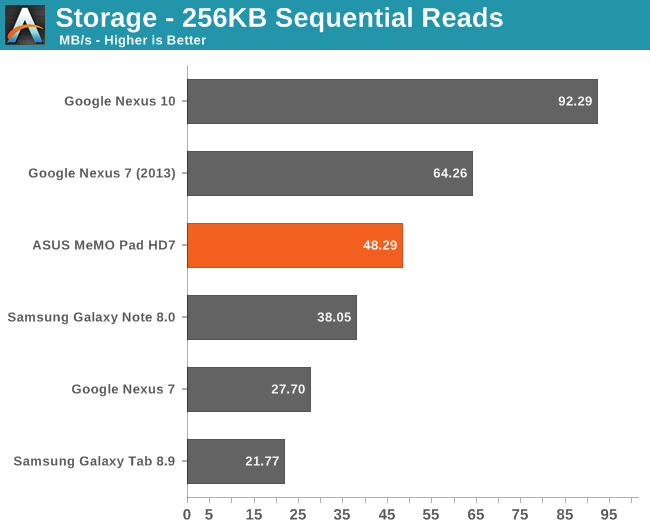
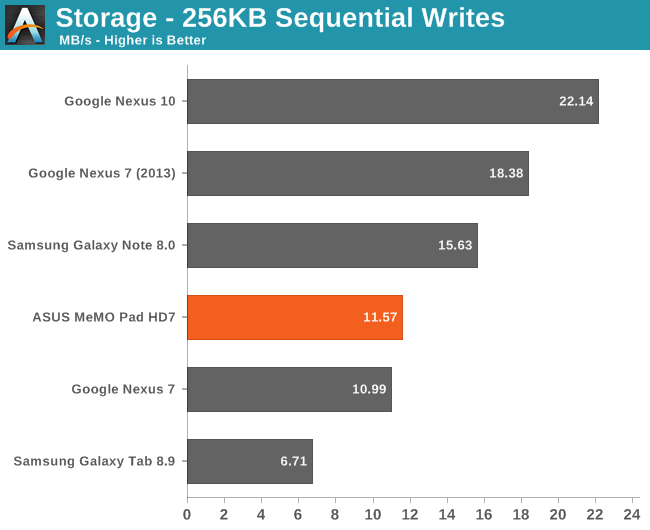
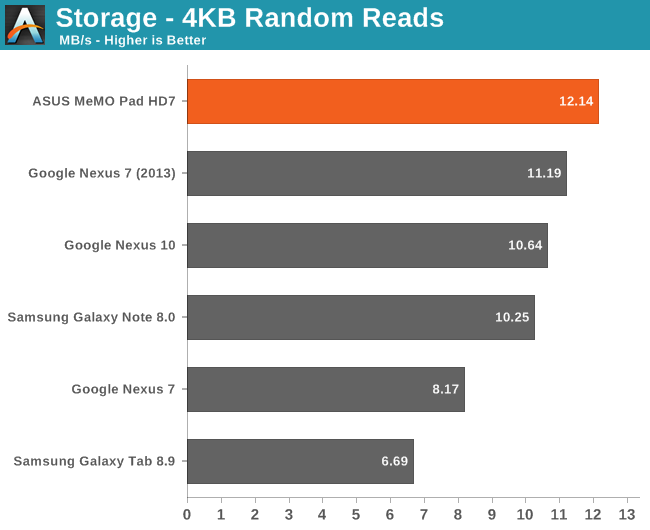
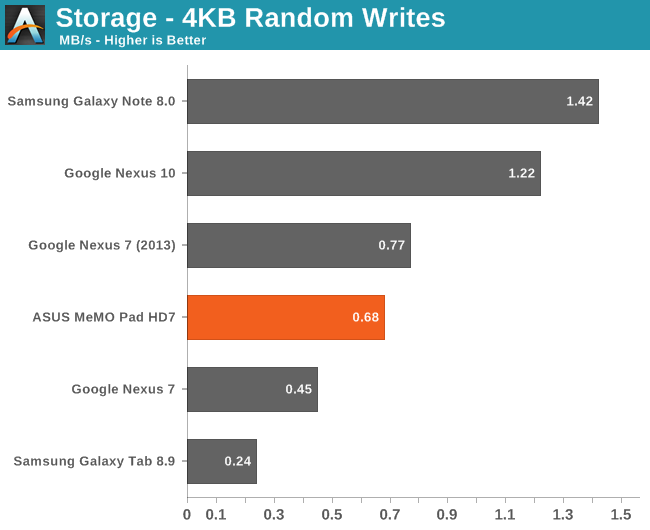
Quite possibly the biggest tradeoff/drawback, the MeMO Pad HD7 only features a single antenna 2.4GHz 802.11n WiFi solution. WiFi is provided courtesy of MediaTek's own MT6628 WiFi/BT/GPS/FM combo chip.
Its peak performance is actually really good though:
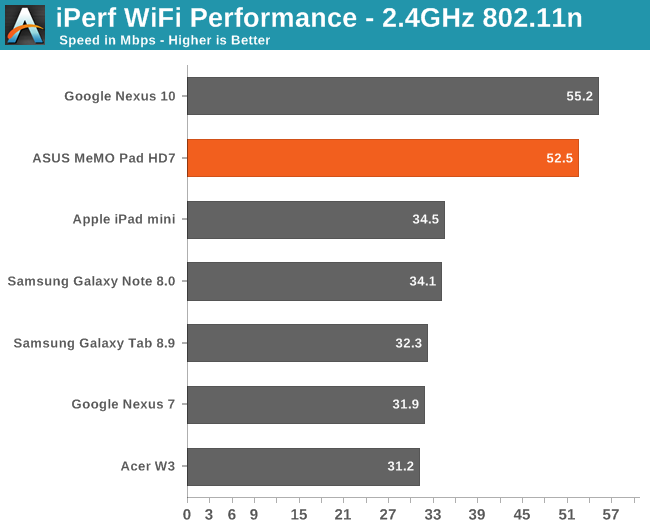
Although GPS is supported by the MT6628, GPS isn't enabled on the HD7. Update: I was very wrong here. GPS is supported and enabled on the MeMO Pad HD7. Sorry!
The 5MP rear facing camera is a nice addition over the original Nexus 7. Image quality is reasonable in a pinch. ASUS' camera UI is nice and quick, with a high framerate downsampled preview. As always, toss enough light on the subject and the results can be pretty decent:
I threw some sample images in the gallery below. Video is encoded at 17Mbps H.264 main profile.


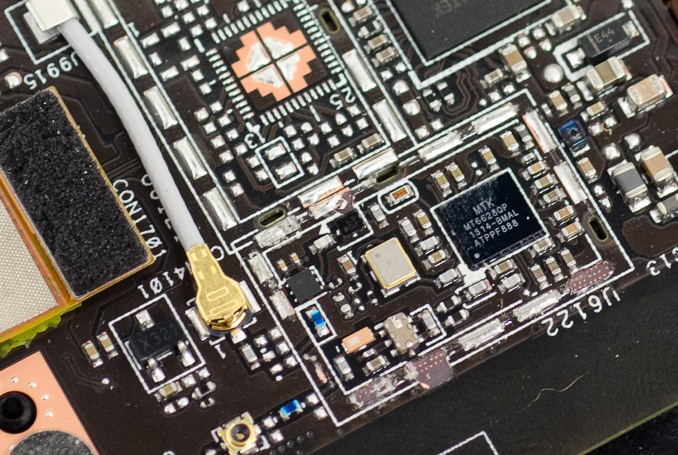















75 Comments
View All Comments
rabidpeach - Tuesday, July 30, 2013 - link
considering sdhx is mostly a microsoft invention, it might not be well supported in the android universeMonkeyPaw - Monday, July 29, 2013 - link
The big issue now is that places will be clearing Nexus 7.1 stock out. I already see the 16GB listed for $170 (or less for refurbs). You can get a 32GB N7.1 for $199 at Microcenter.Death666Angel - Monday, July 29, 2013 - link
I guess people who want the Nexus experience will still get a Nexus, people who want mSD support, a rare facing camera and a lighter chassis will get the HD 7. And other markets are different as well, here in Germany, the N7 2012 is still at the normal prices: 199€ for the 16GB one over the Play Stor, 238€ for the 32GB one at a normal store with the Play Store being 249€. That makes the HD 7 a lot cheaper, white being 139€ and the rest being 149€, that's not much absolutely, but relatively quite the pay up to get an N7. :)nafhan - Monday, July 29, 2013 - link
So... unless the MicroSD slot is really important, the best bet for bargain hunters may be to look for a deal on last year's N7. I've seen those hit this price point a few times (new).blanarahul - Monday, July 29, 2013 - link
"Like most other quad-core implementations in Android, I rarely see the fourth core turn on. The first two are frequently active, with clock speeds usually up at 1.2GHz whenever you're doing anything (loading apps, scrolling, etc…). The third core usually plugs in to keep responsiveness up while doing anything more CPU intensive, but that fourth core is almost never plugged."I would like to ask. Under what conditions does the 4th core get plugged? How many cores ate used while playing games like Modern Combat 4?
Anand Lal Shimpi - Monday, July 29, 2013 - link
I updated that paragraph a bit to be more specific to the MT8125/MeMO Pad HD7. MC4 tends to use 2 cores from what I've seen:http://images.anandtech.com/doci/7160/Screenshot_2...
peter23 - Monday, July 29, 2013 - link
Maybe all cores might get used if you're streaming music, downloading a torrent and using the nav all at the same time. All cores could get used if you find a video that can only be decoded in software. I don't use Chrome but maybe each tab also uses a separate process like the desktop one. I sometimes open up multiple tabs right after each other and maybe each core will be used to process each tab. These are all guess because I only have a dual-core phone.agentsmithitaly - Monday, July 29, 2013 - link
I'm very happy to see only metric measures except screen diagonals, you guys really listen to your audience!Now what about an Allwinner soc review? Hard to get excited from a performance point of view, but it's amazing to see working 50 $ tablets
abrowne1993 - Monday, July 29, 2013 - link
I feel like there is so much going on in that title.jjj - Monday, July 29, 2013 - link
You should try to find and test a product with Rockchip RK3188 , quad A9 on 28nm with just 25mm2 die size - very curious how it performs and at that size it got to be way cheap.